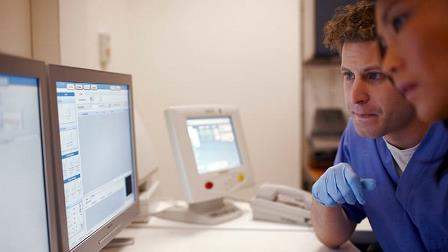Philips and Karolinska University Hospital are developing a tool that will allow specialists from different disciplines to share information about patients with prostate cancer in a more structured way.

Image: Philips and Karolinska University Hospital are developing collaborative tool for prostate cancer care. Photo: courtesy of Koninklijke Philips N.V.
“We want to have the right patient information available at the right time, so we can provide the best possible care in the most efficient way,” said Olof Akre, Professor of urology and head of the prostate cancer care flow at Karolinska University Hospital.
Prostate cancer is the most common type of cancer among men in Sweden; it constitutes more than 1 in 3 of all male cancer cases. Karolinska University Hospital in Stockholm treats up to 1,000 patients with prostate cancer a year.
Specialists from different disciplines enter their findings about patients into electronic medical records, and they also meet regularly to discuss patients. However, Dr. Akre and his team recognized that they could collaborate more efficiently. “There was a lack of shared structure in the way we recorded patient information,” says Dr. Akre. “Sometimes we had to enter the same information twice.”
As part of a larger innovation partnership, Dr. Akre and his team joined forces with Philips to create a web-based application for structured information sharing. “Clinicians from different disciplines have been involved from the start, because we wanted to make sure that the application is tailored to their needs,” says Dr. Akre. “Philips has translated those needs into an easy-to-use application. We now have a well-tested prototype that we are using for a clinical trial.”
Clinicians can enter both text and images into the application. All patient information is stored in a secure and structured database. Based on that information, the application creates a dashboard which shows the right information to the right clinician at the right time. Dr. Akre: “For example, when I’m meeting with a patient, I will immediately get an overview of any side effects the patient might be experiencing from treatment. This means I don’t have to ask the patient unnecessary questions, but instead, I can focus on tailoring the follow-up treatment to the needs of the patient.”
“We will also benefit from the application during our multidisciplinary meetings,” Dr. Akre continues. “When we’re discussing patients together, it saves time and helps with decision-making if we all have the same structured overview of patient information at our fingertips.”
Developing a tool like this can be challenging, Dr. Akre admits. “You need to find a balance between structuring information and allowing enough room for flexibility. On the one hand, you’re trying to create more consistency in the way you record information. On the other hand, you still need a certain level of flexibility, because you want to be able to capture the individual nuances of patient cases. That’s why we tested different versions in an iterative process with experts from Karolinska and Philips.”
“Getting our IT department on board has been a critical success factor as well,” Dr. Akre adds. “Innovation in healthcare is very much about developing digital solutions these days. This project wouldn’t have been possible without the expertise and support of our IT colleagues.”
Currently, a clinical study is being conducted where the application is used to support multi-disciplinary treatment decision making for several hundred men with primary prostate cancer. If the outcome of the clinicial trial is positive, Dr. Akre’s first priority is to make sure that the application becomes part of daily routine.
But there are more opportunities ahead. Karolinska and Philips secured an Horizon 2020 grant from the EU Framework Programme for Research and Innovation. With this grant, the innovation partnership will shift its focus to big data in prostate cancer care.
“Having a structured database will allow us to start building prediction models,” Dr. Akre says. “If you have structured data about 1,000 patients, you can use that data to predict outcomes for the 1,001st patient.
“This will allow us to make even better-informed decisions, based on patient parameters such as the age of the patient and the location of the tumor. Analyzing large data sets could also help us to become more efficient. For example, if you know that it takes longer to operate on patients with certain characteristics, you could adjust your schedule for that. With the right data, we will be able to predict virtually anything ̶ and use these insights to improve the care for our patients.”
Source: Company Press Release
